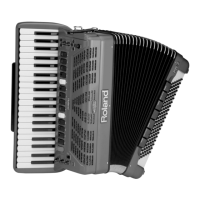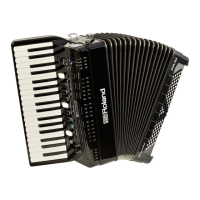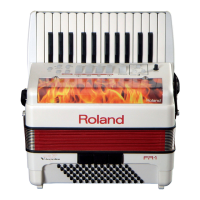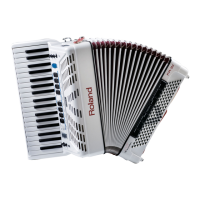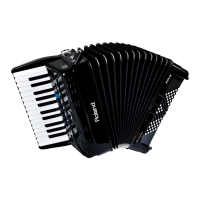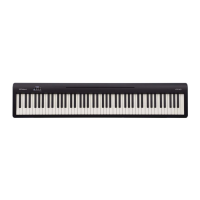Menu Options
74
Parameter Value Explanation
CC 00
Std, O, 0~127
Default: Std
These three messages belong together. The
“oldest” message is called “program change”
or “PC” for short. It is used to select sounds or
memories on the receiving instrument simply
by recalling another sound (or memory) on
the transmitting instrument.
What you set here is transmitted to the FR-8x’s
MIDI OUT socket whenever you select the
register you are currently editing. (You can
set separate addresses for each register.) This
allows you to cause an external module to
select sounds.
Select “O” if a register should not send CC00,
CC32 and/or PC messages. Select “Std” to
transmit the MIDI address of the register you
assign this setting to (Right Hand register [12],
for example, which would then send PC “12”
for CC00= 00/CC32= 00). When you select
“Std” for one of the three parameters (CC00,
CC32, or
PC), the other two parameters also adopt the
“Std” setting.
See the following “Std” table:
CC 32
PC
Std, O, 1~128
Default: Std
Volume
O, 0~127
Default: 100
This parameter allows you to specify the
volume value (CC07) the register should send
to an external device whenever you press
it. That way, the MIDI instrument you are
controlling is automatically set to the desired
level. Remember that selecting “0” silences
the receiving MIDI instrument. Select “O” if
the register should not transmit this message.
NOTE
The FR-8x does not execute this message if
it is returned to the FR-8x via the external
device’s “Soft Thru” function.
Panpot
O, 0~127
Default: 64
This parameter allows you to specify the value
(CC10) the register should send to an external
device when you press it. That way, the MIDI
instrument you are controlling automati-
cally selects the desired stereo position. “0”
corresponds to hard left, “64” to dead center,
and “127” to hard right.
Select “O” if the register should not transmit
this message.
NOTE
The FR-8x does not execute this message if
it is returned to the FR-8x via the external
device’s “Soft Thru” function.
Reverb
O, 0~127
Default: 40
This parameter allows you to specify the
Reverb Send Level value (CC91) the register
should send to an external device when you
press it. Selecting “0” will set the receiving
MIDI instrument to “dry” (no reverb), while
“127” represents the maximum Reverb Send
level. Select “O” if the register should not
transmit this message.
NOTE
If there is no audible change, you may have
to check the reverb eect settings on the
receiving MIDI instrument.
NOTE
Not all MIDI instruments have a reverb
eect, and even if they do, they may not
support this control change number
Parameter Value Explanation
Chorus
O, 0~127
Default: 0
This parameter allows you to specify the
Chorus Send Level value (CC93) the register
should send to an external device whenever
you press it. “0” will set the receiving MIDI
instrument to “dry” (no chorus), while “127”
represents the maximum Chorus Send level.
Select “O” if the register should not transmit
this message.
NOTE
If there is no audible change, you may have
to check the reverb eect settings on the
receiving MIDI instrument.
NOTE
Not all MIDI instruments have a chorus
eect, and even if they do, they may not
support this control changenumber.
Velocity
On, 1~127
Default: On
Your FR-8xx is velocity sensitive. The volume
and brightness of the notes you play on the
right hand or left hand keyboard therefore
depend on how hard (or fast) you press the
keys/buttons. The accordion sounds do not
respond to these playing dynamics, but the
Orchestra (Treble, Bass, Chord, Free Bass)
sounds do and so do most MIDI-compatible
sound modules.
Even though the MIDI standard recognizes
128 dierent velocity values, only 127 can
actually be used for expression purposes. That
explains why the setting range is 1~127. Value
“0” is usually used to signal the end of a note
(i.e. when you release a key or button).
This parameter allows you to specify whether
the velocity values corresponding to the
strength with which you press a key/button
should be transmitted (“On”) or whether your
playing dynamics should not be translated
as such.
In the latter case, you need to select a value
(1~127) that will be applied to all notes that
are transmitted via MIDI. “64” is still relatively
soft. Even lower values are probably not what
you want in most cases. Fixed velocity values
can be useful for playing organ sounds on an
external module.
Note that the setting you select here has no
eect when the “Note Tx” parameter is set
to “O”, because note numbers are always
transmitted along with a velocity value (any
value dierent from “0” also means “start
playing this note”).
Expres-
sion
O, Bellows,
Pedal
Default:
Belows
You probably noticed that the strength/speed
with which the bellows is pressed or pulled
inuences the sound – which corresponds to
an acoustic accordion’s response.
This eect can be translated into a MIDI mes-
sage most external instruments understand.
The MIDI standard provides a message
(“control change”) for remotely controlling the
volume of an external instrument: CC11. It is
chiey used for expression purposes (similar
to the way in which a guitarist or organ player
uses a volume pedal).
If you want to use the bellows for expressive
purposes, set this parameter to “Bellows”.
If you don’t (because the external instrument
is too sensitive and therefore changes its
volume too often), select “O”.
If you purchased an optional MIDI foot
controller (e.g. FC-300) that have a
pedal expression, you can also control the
relative volume by foot. In that case, set this
parameter to “Pedal”.

